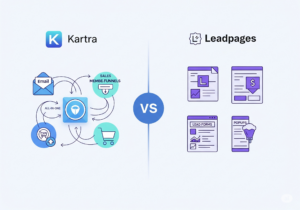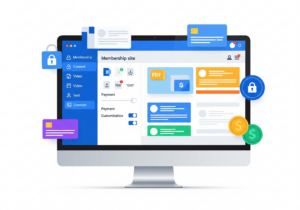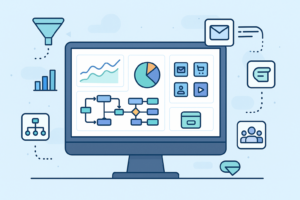
Kartra and Leadpages both help you grow your business online fast. But they serve different purposes, so the choice really depends on you. Kartra is
You must be aware of IKEA. After all, this Swedish multinational conglomerate that specializes in a range of consumer products (from furniture to textiles) needs no introduction. You might also know that IKEA owns over 400 stores in 50+ markets worldwide.
However, you may not be aware that there was a point when IKEA struggled to protect its business against fierce competition from digitally-savvy counterparts. eCommerce was rapidly becoming the norm, while IKEA remained a glaring exception.
Would it not be tragic if one of the biggest retail companies collapsed simply due to an inability to keep abreast with the changing trends? Well, IKEA stepped up to the plate, and took its marketing to digital platforms, and the result? From the most distributed product catalogs to the most viral marketing videos!
Whether your company is a well-established brick-and-mortar or you’re still in the fledgling stages, there are a few things you must remember if you want to grow your customer base-
This guide will cover the A to Zs of basic digital marketing so that you will be familiar with the different channels and have actionable insights on choosing the ideal one for your business, along with solid steps and tips to implement digital strategies.
Affiliate Disclaimer: I earn commission (get paid) if you click on the links and purchase a product below. My earnings do not impact the price you pay.

Simply put, digital marketing refers to any marketing effort through digital or online channels. Some top digital channels include email, social media, paid search, search engines, and more. For your growing business, you should ideally employ several digital tactics to connect with customers online.
Two essential requirements for successful digital marketing are a website and brand profile across social media channels such as Instagram, Facebook, Twitter, and more.
Now that we’ve defined digital marketing, let’s dive into the many benefits it has to offer –
If you publish an advertisement on television, radio, magazine, or billboard, there is just limited control over the target audience. Perhaps you may be able to target the typical readership of the magazine or choose a certain demographic or geography, but it is still largely a leap of faith.
However, the bitter truth is that the business world runs best on facts, not just faith. Digital marketing allows you to narrow down your target groups significantly. Even based on your existing customers, you can easily generate ideal customer profiles, or ICPs, for new leads.
It is possible to segment your audience based on highly niche criteria. Just think about it – wouldn’t the likelihood of reaching prospective buyers be higher if the tech company knew the audience’s tech budget, current subscriptions, recently installed tech systems, etc.?
Similarly, a B2B medical device manufacturing company that wishes to target medical directors of hospitals can go beyond the typical geographical targeting. How? By choosing niche criteria such as years of experience, patient volume, number of beds, etc.
With such targeted customizations also comes the benefit of developing hyper-personalized marketing messages. When you send the right message at the right time to the right audience, it is unlikely that you’ll lose time or resources!

You get to control where you wish to spend your marketing dollars. For instance – when you’re new to online marketing, you should ideally experiment with different channels to see and measure the performance.
While running pilot campaigns, do remember that building brand presence, generating leads, encouraging conversions, etc., is a lengthy process. It might take two to three months (or longer) for you to decide whether the results are favorable or not.
In the meantime, choose business-relevant Key Performance Indicators (KPIs) and monitor them. If your goal is to establish a strong brand presence, measure common KPIs such as post impressions, brand name search volume, referral traffic, etc. However, if lead generation is the goal, the suitable KPIs would be customer lifetime value, cost per lead, bounce rate, etc.
The suitable KPIs will give you a clear picture of which platforms work best for your brand. You can direct your efforts to the right channels using this analysis. For example – if paid search is not performing well for you, but Instagram marketing is, you know where to go!
With offline marketing, you are restricted in terms of audience engagement. A TV ad or billboard may attract a buyer’s attention enough to know more about the brand. However, in most cases, the viewer forgets until another such ad pops up.
Thankfully, this is never the case with digital marketing. You can influence the buyer’s journey and engage with your audience from the initial stages. This is more or less like walking the lead down every sales funnel stage.
For instance – there are different kinds of potential buyers floating in the market. Some are completely unaware of the solutions; all they know are their key pain points. Some others are aware of the solutions but are looking for alternatives. Others may be in the final decision-making stage, but they need reassurance that they’re making the right choice.
Each of these leads can be targeted and converted into paying customers. For those in the awareness stage, you can target using light, short content such as blogs or infographics (just enough to spark an interest). Those in the subsequent stages can be targeted using long-form content such as case studies, industry reports, eBooks, etc., while those in the final stage can be targeted with product catalogs, customer testimonials, etc.
You can use a combination of different digital channels, such as email and social media, with telecall follow-ups. Proper sales cadences will fast-track the process in your favor. By meeting your customer at every step of the buying journey, you also build trust and form solid relationships for the future.
Just like the introductory example of IKEA, digital marketing has been widely adopted by brands worldwide across various industry verticals. This is especially true with COVID-19. In fact, the CAGR of digital marketing is a whopping 9%, with the industry expected to reach $786.2 billion by 2026.
As more brands realize the importance of digital marketing, they are jumping on board. This holds true for those who sell goods offline, mainly because the internet is a powerful tool to connect people (regardless of global or localized).
A solid digital marketing strategy is necessary if you want to stay in the game. Get started by building a mobile-optimized, user-friendly website. Create social profiles that clearly demonstrate your brand voice, tone, and vision, and start churning out relevant content for your target audience.
You can even seek help from a reliable third-party data partner, give them your unique specifications, and use the database as a foundation for connecting with lucrative leads across different digital channels.
Direction is more important than speed. Now that we’ve discussed what digital marketing is and its benefits, let’s get you started on a definite path toward success.
Listed below are some tried-and-true steps you should take to stay on the right path.
When you’re just starting out, digital marketing, with its many channels, analytics, and jargon, can seem like a maze. The best way out is to know exactly where you want to go. Meaning, map out a SMART goal.
You can also join the success group by establishing SMART goals, where each letter gives a clear cue for setting a goal. Let’s see how –
Once you know yourself, you need to know precisely to whom you wish to market your offerings. It is possible to be extremely specific about your target audience, but it takes some practice. Always start by creating an ideal buyer persona.
Segment your audience into three to four buckets based on shared interests, pain points, job titles, geographical location, etc. Then, give the persona a makeshift name and character. Now, search the market for leads showing the strongest buying signals with the most shared characteristics.
Don’t just stop at creating a persona. Go a step ahead by scoring your leads. Even among good leads, the level of sales readiness may vary. You can do this by assigning lead points for meeting behavioral criteria.
There are several ways to judge this – which format is the most useful for your brand and what defines sales readiness differs in every brand’s books.
For instance – Not all subscriptions indicate the same degree of sales-readiness. Leads that subscribe to blog updates may not convert into paying customers. However, leads that subscribe to unlock a whitepaper most likely will. At the end of the day, lead scoring is based on your discretion.
Once you’ve sorted out your business goals and the target audience, ask yourself whether you’re thoroughly aware of your brand’s character. Running a brand health check will help you determine how you and your customers fit together in the marketing puzzle.
A couple of good questions to answer would include –
Knowing your brand inside-out in relation to the customer and their needs gives you unmatched confidence to develop digital marketing content that attracts, engages, and converts. Customers look for brands they can relate to, and the best way to relate to them is to know yourself and them.
For instance – You come up with a new product and pitch it to a small group of relevant customers. Then, you decide to run a short survey to gather feedback. In a majority of cases, you will hear the customers mention that they found the product’s functioning challenging or confusing.
In such a case, you can target your new batch of leads with a product demo video that walks them through the entire process. So you see, you address a pain point for the existing customers, which also proves beneficial in generating new leads.
Most brands regard other companies who offer similar products as competitors. However, nothing could be further from the truth. To have a 360-degree view of the present market, it is vital to think of your competitors in three different ways –
Once you know exactly who you’re up against, now is the time to run a thorough competitor analysis. Learn how they structure their website, what content they frequently publish, what their customers are saying, and so on.
You should also look for the various gaps in your competitor’s content strategies, landing pages, etc. This will help you fill those gaps and highlight your distinctiveness to the target groups. Finally, stay on top of the news and marketing trends by noting down your competitors’ gains and losses. It’s always best to learn from others’ mistakes, right? Follow a simple mantra – do what they’re doing right, rectify in yourself what they’re doing wrong, and you’re halfway through to success!

Once you’ve diligently followed the steps mentioned above, it’s time for a showdown! Yes, now is the time to deploy pilot campaigns that will help you measure marketing success for each channel.
There are numerous digital marketing channels to select from. These include –
Your customers always search for relevant answers on a search engine (Google). You can leverage this by ensuring your content ranks on top of the search results. This involves optimizing your website in such a manner (with relevant keywords and all) that it ranks at the top.
To ensure your page ranks at the top, ensure your content is relevant to your target audience, taken from credible sources, is easy to read and scan through, is accurate, and, most importantly, is well-optimized for mobile users.
Also known as pay-per-click ads, these work along the lines of search engine rankings. However, the critical difference here is that you pay each time an ad gets clicked, and in return, the search engine offers you a spot at the top of the page based on a set of relevant keywords.
The fee is often worth it since you can stay in the most visible area on a search result page. However, thoroughly search for your niche’s most commonly used keywords to get the pay-per-click model right.
You must be aware of the ROI-churning power of email marketing. The main thing needed to ace email marketing is ace content personalization. Go beyond your lead’s first name.
Address their relevant pain points immediately and hint at how you can provide solutions. Use stats, images, and even multimedia, if possible, to emphasize your point and sound credible. The subject line should be catchy to draw the reader’s attention. However, the content should be authentic, specific, to the point, and relevant to the reader.
Use this channel to share reminders, newsletters, flash sales, discounts, etc.
This platform is second only to email in terms of brand engagement and results. Research where your target groups are most frequently gathering – Twitter, Facebook, Instagram, Pinterest, LinkedIn, and more.
Choose a combination of these channels because each channel comes with unique marketing and analytics features. Social media marketing aims to publish thought leadership content that singles you out as an authority figure within your industry.
From short-form to long-form content, you can share it all. You can start relevant discussions around recent industry news or new product launches to understand your target groups’ thoughts. While social media does help in sales, the primary purpose is to drive engagement and stay on top of your customer’s minds.
Over the past decade, the number of mobile phone users has just skyrocketed. Since almost everyone owns a smartphone and scrolls through it multiple times throughout the day, it only makes sense to target them here.
While in the later stages of business growth, you can create your mobile application that streamlines product purchases and start by making your website mobile-optimized. You can also create Quick Response (QR) response codes to help customers go to your website to make payments and more.
Plus, you can also start text marketing. First, ask your website visitors if they’d like to stay in the loop by receiving regular product updates. If they mark yes, you can send them relevant text messages to notify them of a new launch, discounts, time-sensitive offers, and more.
Once you’ve chosen your strategy and implemented it, the next thing to do is to wait and measure. Yes, measuring and analyzing campaign performance is key to understanding the direction in which you’re headed.
Not doing so can have repercussions – wasted time and resources chasing after irrelevant leads, decreasing conversion rates, loss of ROI, poor campaign decisions, and choice of the wrong marketing channels. It will become a vicious cycle that can only be broken through performance measurement and analysis.
Use different KPIs to measure your campaign performance, see which channels are performing well, eliminate the others (or keep the frequency low), and make changes to your campaign efforts and budget accordingly.
Even though digital marketing has risks, and you may not get it right each time, monitoring performance and making consistent changes can help you minimize those risks.

Kartra and Leadpages both help you grow your business online fast. But they serve different purposes, so the choice really depends on you. Kartra is

A membership site gives content only to people who sign up first. It’s great for courses, training, digital products, or private communities. You control who

Kartra is an all-in-one platform made for online businesses. It helps you build, launch, and grow your business from one place. You don’t need ten
Copyright 2021 Dwayne Graves Online | All Rights Reserved |